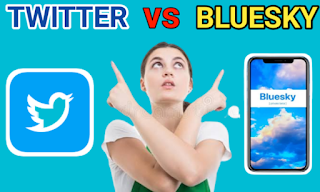A Comparative Analysis of Bluesky and Twitter: Similarities and Differences in Features
Introduction to Bluesky Social and Twitter
Bluesky Social and Twitter are two popular social media platforms that have gained significant attention over the years. Twitter has been around since 2006 and has over 353.9 million active users as of 2023. It is known for its short-form content, where users can post updates, share links, and communicate with others by using 280 characters or fewer. Twitter is a highly interactive platform and has become a go-to channel for real-time conversations, news updates, and customer support.
Read Also: Step by Step Guide On How To Create a New Bluesky Account
On the other hand, Bluesky Social is relatively new in the social media space. It was first announced in 2019 by the then-Twitter CEO Jack Dorsey, as a “spin-out” organisation handled by the company, and it is a decentralized social media protocol that aims to create an open and verifiable social media ecosystem. It is still in the development phase and has not yet been launched for public use. The goal of Bluesky Social is to enable users to have more control over their social media experience and to provide more transparency in content moderation.
Although Bluesky and Twitter have some similarities, they are fundamentally different in terms of their purpose, features, and target audience. Understanding their differences is crucial for businesses and individuals who want to leverage social media for their marketing and communication efforts. In the following sections, we'll dive deeper into the features of each platform and compare them side by side.
Comparison of User Interface and User Experience
When it comes to the user interface (UI) and user experience (UX), there are notable differences between Bluesky Social and Twitter.
Bluesky has a simpler and more streamlined UI, which makes it very easy for users to navigate. The platform has a minimalist design and all the features are neatly arranged, making it easier for users to find what they are looking for. The user experience is smooth and intuitive, with minimal clutter and distractions. Users can easily access the platform's features and settings from the dashboard, making it easier to customize their experience according to their preferences.
On the other hand, Twitter has a more complex UI, with a range of features and settings that can be overwhelming for new users. The platform has a lot going on, with its timeline, notifications, direct messages, and trending topics all on one screen. While this can be great for users who want to stay up-to-date on a range of topics, it can also be difficult for new users to navigate.
When it comes to user experience, Bluesky has a more personalized approach than Twitter. The platform allows users to customize their feed, follow only the people or topics they are interested in, and block or mute users they don't want to see. This helps to create a more positive and tailored experience for users. Twitter, on the other hand, can often feel like a noisy and chaotic place, with tweets from accounts that users don't follow appearing on their timeline.
In summary, while both platforms have their strengths and weaknesses, Bluesky's simple and user-friendly UI and personalized UX make it a great option for those looking for a more streamlined and tailored social media experience.
Bluesky vs. Twitter: Features and Functionalities
When it comes to comparing Bluesky Social and Twitter, it's important to take a closer look at their features and functionalities to determine which platform is the right fit for your needs.
Twitter is a social media platform that allows users to send and read short messages called "tweets". Users can follow other users, like and retweet posts, and engage in conversations through replies and direct messages. Twitter is known for its fast-paced, real-time nature, making it a popular platform for breaking news, live events, and customer service interactions.
On the other hand, Bluesky Social is a social media management tool that helps businesses and individuals schedule and publish content across multiple social media platforms, including Twitter. Bluesky Social allows users to create and curate content, schedule posts in advance, and track analytics to measure the success of their social media strategy.
In terms of features, Twitter offers a variety of tools for users to customize their profile, including the ability to add header images, profile pictures, and bio information. Twitter also offers a search function to help users find and engage with relevant content and users. Bluesky Social, on the other hand, offers more robust features for social media management, including the ability to schedule posts across multiple platforms, track analytics, and collaborate with team members.
In summary, I would say, whether you choose Bluesky or Twitter will depend on your specific needs and goals. If you're looking for a fast-paced platform to engage with customers and stay up-to-date on the latest news and trends, Twitter may be the right choice for you. If you're looking for a comprehensive social media management tool to help you create and track a successful social media strategy, Bluesky Social may be the better option.
Similarities and Differences in Posting and Sharing Content
Both Bluesky and Twitter are social media platforms that allow users to post and share content with their followers. However, there are some notable differences in how these two platforms handle content sharing.
On Twitter, users can post tweets, which are limited to 280 characters in length. Users can also share links, images, and videos within their tweets. In contrast, Bluesky allows users to create longer posts, similar to a blog post, with no character limits. Users can also upload images and videos, but Bluesky Social also offers the ability to upload audio files and PDF documents.
Another key difference is in how content is shared. On Twitter, users can retweet content from others, meaning they can share someone else's tweet with their own followers. Bluesky Social does not have a direct retweet feature, but users can share posts from others by reposting the content to their own profile.
Additionally, Bluesky Social offers the ability for users to schedule posts in advance, which can be a useful feature for businesses and individuals who want to plan their social media content in advance. Twitter does not have this feature built-in, but there are third-party tools that can be used to schedule tweets.
Overall, while both Bluesky Social and Twitter offer similar features in terms of posting and sharing content, there are some key differences in how these features are executed. Understanding these differences can help users make informed decisions about which platform is best suited for their needs.
Bluesky and Twitter: Interactivity and Networking
Bluesky and Twitter are both social media platforms that focus on interactivity and networking. Both platforms allow users to interact with each other through commenting, liking, and sharing posts. Twitter allows users to retweet posts, while Bluesky Social allows users to repost content. Both platforms also allow users to tag other users in their posts and comments, which is a great way to engage with other users and expand your network.
However, there are some differences between the two platforms in terms of interactivity and networking. Twitter is a more fast-paced platform that allows users to share quick updates and thoughts in real-time. This makes it a great platform for networking with other professionals and engaging with trending topics. Bluesky Social, on the other hand, is a more visual platform that allows users to share images and videos along with their posts. This makes it a great platform for businesses that want to showcase their products or services in a more interactive way.
Another difference between the two platforms is the way they handle interactions. Twitter has a more open approach to interactions, which means that anyone can see and engage with your posts. Bluesky Social, on the other hand, has a more closed approach to interactions, which means that only your followers can see and engage with your posts. This can be a disadvantage for businesses that want to reach a wider audience, but it can also be an advantage for businesses that want to maintain a more exclusive brand image.
Overall, both Bluesky Social and Twitter are great platforms for interactivity and networking, but they have some differences in terms of their approach and features. It's important to understand these differences and choose the platform that best suits your business needs and goals.
A Comparison of Search and Discovery Tools
When it comes to search and discovery tools, Bluesky Social and Twitter have some similarities and differences. Both platforms have a search bar where users can enter keywords or hashtags to find relevant content. However, Bluesky Social has a more advanced search feature that allows users to filter results by location, date, sentiment, and language.
Twitter also has a search feature but it mainly relies on hashtags and keywords to deliver results. One of the main differences between the two platforms is that Bluesky Social offers a feed of suggested content based on a user's interests and activity. This feature can help users discover new content and connect with others who share their interests.
Another notable difference is that Twitter has a trending topics section that displays the most popular hashtags and topics at the moment. This can be useful for businesses and marketers who want to stay on top of what's trending and create content around those topics.
Overall, both platforms have their strengths when it comes to search and discovery tools. Bluesky's advanced search feature and suggested content feed make it a great option for those looking to discover new content and connect with others. On the other hand, Twitter's trending topics section and reliance on hashtags make it a valuable tool for businesses and marketers looking to stay on top of what's popular and create content accordingly.
Privacy and Security: How Bluesky Social and Twitter Compare
Privacy and security are two important aspects that users consider when choosing a social media platform. Bluesky Social and Twitter both have their own set of features to ensure user privacy and security.
Twitter has a variety of security measures in place, such as two-factor authentication and encryption for direct messages. They also have a dedicated team that monitors and investigates any potential security threats. Twitter's privacy policy outlines how they collect and use user data, as well as how users can control their privacy settings.
Bluesky Social, being a new platform, has not yet revealed their full privacy and security measures. However, it has been reported that Bluesky Social is being designed with a focus on decentralization, which means it will be less reliant on a central authority for storing user data. This could potentially make Bluesky Social more secure than centralized social media platforms, as there is less of a risk of a single point of failure.
Overall, while Twitter has been established for a longer period of time and has a more established set of privacy and security features, Bluesky's focus on decentralization may make it a more secure platform in the long run. It remains to be seen how Bluesky's privacy and security features will compare to Twitter's once the platform is fully launched.
Analytics and Insights: Differences and Similarities
Both Bluesky Social and Twitter offer analytics and insights into your social media presence. The main difference in this aspect is the level of detail provided by each platform. Twitter provides a basic overview of your account's performance, such as the number of profile visits, mentions, and tweet impressions. However, Bluesky Social takes this to the next level by providing detailed reports on engagement, audience growth, demographics, and content performance.
Bluesky's analytics are far more detailed and informative than Twitter's, allowing you to gain a deep understanding of your audience's behavior and preferences. It provides data on which content performs the best, what time of day your audience is most active, and which hashtags are most effective in reaching your target audience. This level of detail can help you make data-driven decisions and optimize your social media strategy.
Twitter's analytics are more straightforward and basic, which may be suitable for smaller businesses or individuals who don't require an in-depth analysis of their social media performance. Twitter's analytics provide insights into your top tweets, followers, and mentions, which can still be helpful in understanding how your account is performing.
Overall, Bluesky Social provides a higher level of detail and insights into your social media performance than Twitter. However, the level of detail required will depend on your business needs and the size of your audience.
Pros and Cons of Bluesky Social and Twitter
Before deciding on which platform to use for your social media marketing, it's important to weigh the pros and cons of Bluesky Social and Twitter.
Bluesky Social is a relatively new social media platform that aims to provide a decentralized and open-source alternative to existing social media giants. One of the biggest advantages of Bluesky Social is that it operates on a decentralized system, meaning that it is not controlled by any single entity or organization. This ensures that there is no central authority that can manipulate or censor content. Additionally, Bluesky Social is built on open-source software, which means that anyone can contribute to its development and improvement.
On the other hand, Twitter is a well-established social media platform that has been around for over a decade. One of the biggest advantages of Twitter is its massive user base, which makes it an ideal platform for businesses looking to reach a wide audience. Additionally, Twitter has a number of features such as hashtags, retweets, and mentions, which make it easy for businesses to engage with their audience.
However, there are some downsides to using Twitter. One of the biggest issues with Twitter is the prevalence of hate speech and other types of harmful content. This can make it difficult for businesses to maintain a positive brand image and can also lead to legal and reputational issues. Additionally, Twitter's algorithm can be unpredictable, which means that businesses may have difficulty reaching their target audience.
Ultimately, the choice between Bluesky Social and Twitter will depend on your specific needs and goals. While Bluesky Social offers a more decentralized and open-source alternative, Twitter has a larger user base and more established features. It's important to carefully consider the pros and cons of each platform before making a decision.
Conclusion and Recommendations for Users
In conclusion, both Bluesky Social and Twitter have unique features that make them stand out in the social media world. While Bluesky Social offers a more streamlined and professional platform for businesses, Twitter is more suited for casual users who want to connect with others and share their thoughts and opinions.
If you're a business owner looking for a robust social media platform to promote your brand and connect with potential customers, Bluesky Social is definitely worth considering. Its advanced analytics and reporting features make it easy to track your performance and adjust your strategies accordingly.
On the other hand, if you're an individual looking to connect with others and stay up-to-date on the latest news and trends, Twitter is a great option. Its real-time updates and vast network of users make it easy to find and join conversations on almost any topic.
Regardless of which platform you choose, it's important to have a clear understanding of your goals and target audience before diving in. By tailoring your content and engagement strategies to your specific audience, you'll be able to maximize your results and achieve your social media objectives.
Overall, both Bluesky Social and Twitter have their pros and cons, and the best choice ultimately depends on your specific needs and preferences. Whether you're a business owner or an individual user, both platforms offer great opportunities to connect with others and build your online presence.
We hope you found our comparative analysis of Bluesky Social and Twitter helpful in understanding the similarities and differences in these two social media platforms. Both have unique features and functions that can be beneficial to individuals and businesses looking to grow their social media presence. By understanding these differences, you will be able to make informed decisions about which platform is right for you. Thank you for reading, and we hope that this article has helped you in your social media journey.




.jpg)
.gif)


.jpg)



